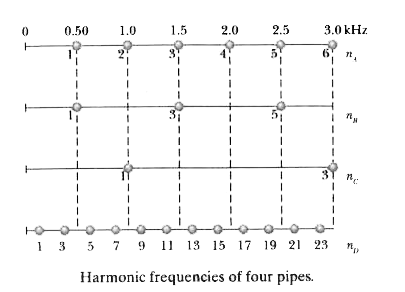Pipe A is open at both ends and has length LA = 0.343 m. We want to place it near three other pipes in which standing waves have been set up, so that the sound can set up a standing wave in pipe A. Those other three pipes are each closed at one end and have lengths LB=0.500LA,LC=0.250LA and LD = 2.00L. For each of these three pipes, which of their harmonics can excite a harmonic in pipe A?
(1) The sound from one pipe can set up a standing wave it another pipe only if the harmonic frequencies match. (2) Equation gives the harmonic frequencies in a pipe with two open ends (a symmetric pipe) as f = nv/2L, for n 1,2,3,..., that is, for any positive integer. (3) Equation 17-40 gives the harmonic frequencies in a pipe with only one open end (an asymmetric pipe) as f= nv/4L, for n = 1, 3, 5, ..., that is, for only odd positive integers.
Pipe A: Let.s first find the resonant frequencies of symmetric pipe A (with two open ends) by evaluating Eq.
fA=nAv2LA=nA(343m/s)2(0.434m)
=nA(500Hz)=nA(0.50kHz), for onA=1,2,3,..........
The first six harmonic frequencies are shown in the top plot in Fig.
Pipe B: Next let.s find the resonant frequencies of asymmetric pipe B (with only one open end) by evaluating Eq., being careful to use only odd integers for the harmonic numbers:
fB=nBv4LB=nBv4(0.500LA)=nB(343m/s)2(0.343m)
nB(500Hz)=nB(0.500kHz), for nB=1,3,5,.....
Comparing our two results, we see that we get a match for each choice of nB :
fA=fB for nA=nB with nB=1,3,5............
For example, as shown in Fig. , if we set up the fifth harmonic in pipe B and bring the pipe close to pipe A, the fifth harmonic will then be set up in pipe A. However, no harmonic in B can set up an even harmonic in A.
Pipe C: Let.s continue with pipe C (with only one end) by writing Eq. as
fC=nCv4LC=nCv4(0.250LA)=nC(343m/s)0.343m/s
nC(1000Hz)=nC(1.00kHZ), for nC=1,3,5,......
From this we see that C can excite some of the harmonics of A but only those with harmonic numbers n, that are twice an odd integer:
fA=fC for nA=2nC, with nC=1,3,5,.......
Pipe D: Finally, let.s check D with our same procedure:
fv=nDv4LD=nDv4(2LA)=nD(343m/s)8(0.343m/s)
=nD(125Hz)=nD(0.125kHz), for nD=1,3,5,.....
As shown in Fig., none of these frequencies match a harmonic frequency of A. (Can you see that we would get a match if nD=4nA ? But that is impossible because 4nA cannot yield an odd integer, as required of nD.) Thus D cannot set up a standing wave in A.

Related Playlists
- BOOK - RESNICK AND HALLIDAYCHAPTER - WAVE - IIEXERCISE - CHECKPOINTS4videos
WAVE - II
- BOOK - RESNICK AND HALLIDAYCHAPTER - WAVE - IIEXERCISE - PROBLEMS59videos
WAVE - II
- BOOK - RESNICK AND HALLIDAYCHAPTER - VECTORS EXERCISE - PRACTICE QUESTIONS39videos
VECTORS
- BOOK - RESNICK AND HALLIDAYCHAPTER - WAVES-IEXERCISE - Practice Questions (Integer Type)4videos
WAVES-I
Similar Questions
The waves set up in pipes open at both the ends are
View SolutionPipe A is 0.50 m long and open at both ends. Pipe B is open at one end and closed at the other end. Determine the length of pipe B so that it has the same fundamental frequency as A.
View SolutionShow that an organ pipe of length 2l open at both ends has the same fundamental frequency as another pipe of length I closed at one end.
View SolutionTwo closed organ pipes have lengths L and L+X. When two pipes are sounded together , the beat frequency is
View SolutionA standing wave in second overtone is maintained in a open pipe of length l. The distance between consecutive displacement node and pressure node is……………
View SolutionProve that a pipe of length 2l open at both ends has same fundamental frequency as another pipe of length l closed at the other end. Also, state whether the total sound will be identical for two pipes.
View SolutionTwo organ pipe , both closed at one end , have lengths landl+Δl. Neglect end corrections. If the velocity of sound in air is V, then the number of beats//s is
View SolutionTwo organ pipe , both closed at one end , have lengths landl+Δl. Neglect end corrections. If the velocity of sound in air is V, then the number of beats//s is
View SolutionA standing wave in second overtone is maintained in a open pipe of length L. The distance between consecutive displacement node and pressure node is L/x. Find x
View SolutionAn organ pipe of length L is open at one end and closed at other end. The wavelengths of the three lowest resonating frequencies that can be produced by this pipe are
View Solution

